A recent study by a large health insurance company found that people who were given an Apple Watch moved as much as 51% more than before. Besides helping you move more, these devices can help give you more information about your health. Here are some mobility insights available to users of iPhone that you may not have known about.
The study in question was directly linked to incentives that the insurance company offered based on the amount of movement, so from that perspective it doesn’t have much scientific value. But reading about it caused me to consider how much I appreciate the impact my Apple Watch and iPhone have on my overall commitment to staying active. The data they offer motivate me to do more than I normally would. Perhaps you have a different smart watch and/or phone. It doesn’t matter what brand you use. The point is that these modern tools can help us be more active, which is always a good thing.
Many users of iPhone and Apple Watch are unfamiliar with the rich insights available on mobility and health. This post might shed some light on the data you have at your fingertips.
Mobility
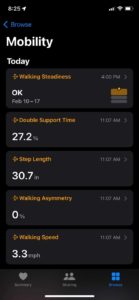 To access your iPhone’s Mobility data, go to your Health App, select the “Browse” menu and then tap on “Mobility.” You’ll see a list of mobility insights available. You may have to activate some of them if you’ve never used them. Here you’ll have access to such details as your Step Length, Walking Asymmetry, Walking Balance and more.
To access your iPhone’s Mobility data, go to your Health App, select the “Browse” menu and then tap on “Mobility.” You’ll see a list of mobility insights available. You may have to activate some of them if you’ve never used them. Here you’ll have access to such details as your Step Length, Walking Asymmetry, Walking Balance and more.
How important is this info? It depends on how serious you are about your long-term health. For example, you might never even have thought about the asymmetry of your walking steps. But if you’ve been injured, or you’re getting on in years, this information can be invaluable. Knowing how asymmetrical your steps are can help you correct deficiencies before they become really serious. Tracking changes can help you fix issues that might be creeping up on you that you would otherwise be unaware of.
Double Support Time
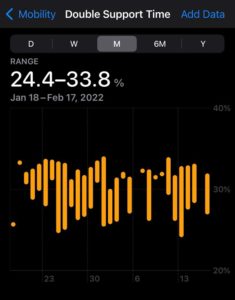 Double Support Time refers to the percentage of time while walking that both feet are on the ground.
Double Support Time refers to the percentage of time while walking that both feet are on the ground.
As you walk, you move from one foot to the other. As you transfer your weight, there will be a moment that you are only on one foot. This metric calculates that time. A lower value means that you are more balanced, because you need less time where your weight is on one foot instead of two. For most people, the value will fall between 20 and 40%.
Double Support Time varies with how fast you walk and the terrain. For dancers, it may vary dramatically due to the style of dance. However, it is only measured when you have your iPhone with you and located near your waist, which isn’t likely when you’re dancing.
Walking Steadiness
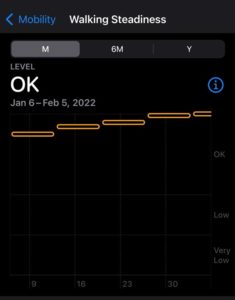 Walking Steadiness is an estimate of your stability when you walk. Steadiness is related to your risk of falling, which can be important as you get older.
Walking Steadiness is an estimate of your stability when you walk. Steadiness is related to your risk of falling, which can be important as you get older.
While it’s not an indication of your risk of falling at any given time, it does provide an overall sense of fall risk over a long period of time, such as the year ahead. It is measured when you carry your iPhone near your waist.
If you are aging or at risk of a fall, you can even set up notifications in your Health Checklist to alert you if this is dropping to an unsafe level.
Step Length
 Step Length is the distance between your front and back foot when you’re walking. The ability to take longer steps is directly related to your long-term mobility.
Step Length is the distance between your front and back foot when you’re walking. The ability to take longer steps is directly related to your long-term mobility.
Of course, step length will vary based on your walking speed, your height, and the type of surface you’re walking on. This metric can alert you to changes over time due to age, injury and other factors.
To be measured accurately, you need to carry your iPhone near your waist as you walk on flat ground.
Walking Asymmetry
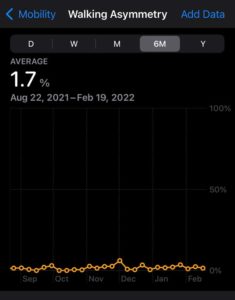 Normally, when we walk, the timing of the steps taken with each foot are quite similar. Walking Asymmetry tracks the percentage of time that your steps with one foot are faster or slower than those with the other foot. The lower the percentage, the healthier your walking pattern.
Normally, when we walk, the timing of the steps taken with each foot are quite similar. Walking Asymmetry tracks the percentage of time that your steps with one foot are faster or slower than those with the other foot. The lower the percentage, the healthier your walking pattern.
Injuries and other health issues can cause changes in your asymmetry, leading to uneven walking patterns that you may not even be aware of. For example, a hip injury or arthritis can cause you to spend even fractionally less time on one foot than the other, leading to a type of limp that you may not even realize you are using.
This measurement is only possible when you carry your iPhone near your waist, such as in a pocket.
Other Measurements
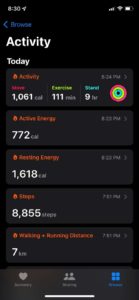 The iPhone records many other health-related measurements. It can keep track of your resting heart rate, active heart rate, blood pressure, VO2Max, Heart Rate Variability and more. It can also track your activity levels, which becomes virtually automatic when combined with an Apple Watch.
The iPhone records many other health-related measurements. It can keep track of your resting heart rate, active heart rate, blood pressure, VO2Max, Heart Rate Variability and more. It can also track your activity levels, which becomes virtually automatic when combined with an Apple Watch.
Calories burned, BMI, stand time, steps and more are recorded by your watch.
In addition, you can track sleep patterns which can also be recorded by your smart phone for analysis. Wendy and I use an Oura Ring to track our sleep and have found it quite valuable in helping us create better habits to improve our sleeping patterns.
These modern electronic devices have come a long way in providing valuable insights to help us improve our health. As they get even more sophisticated, we’re sure to see even more useful information in the years to come.














